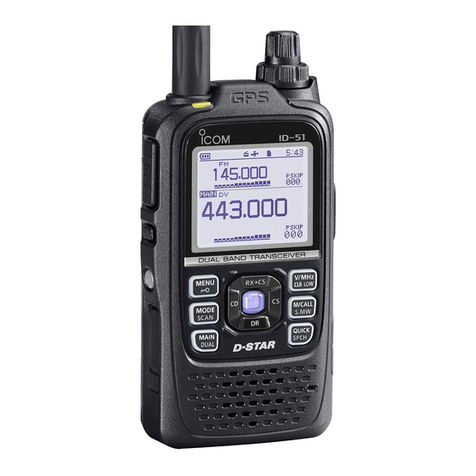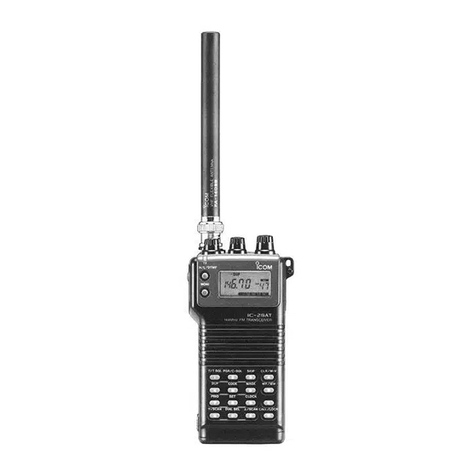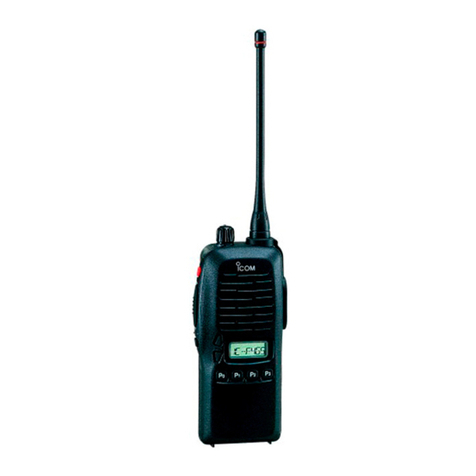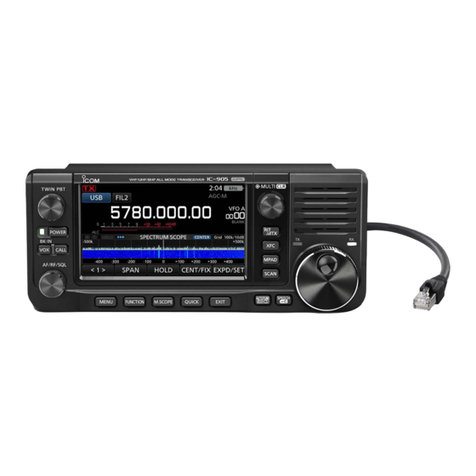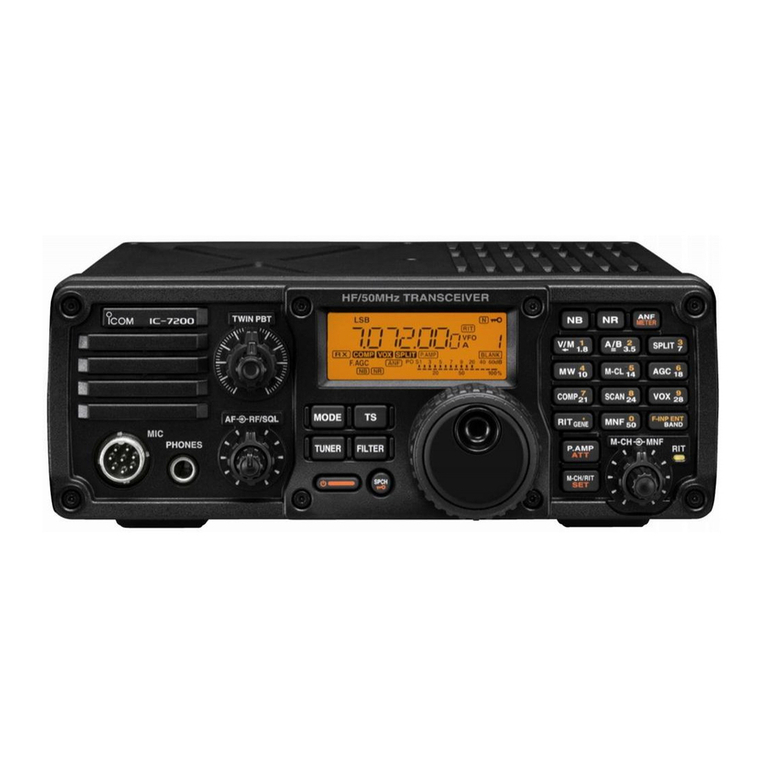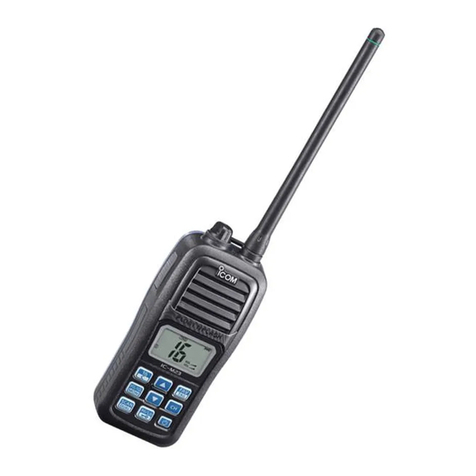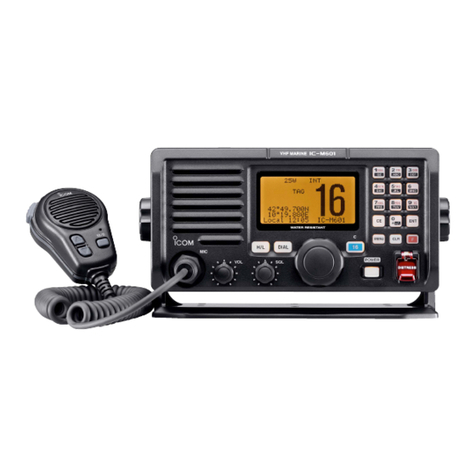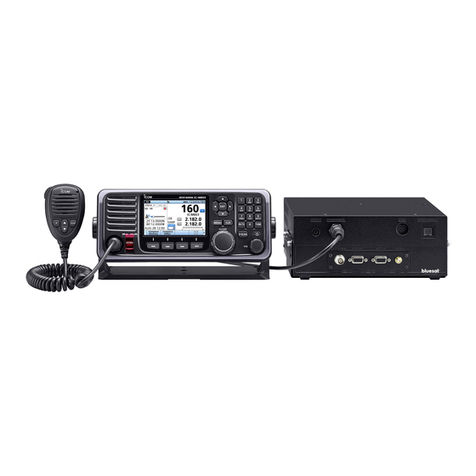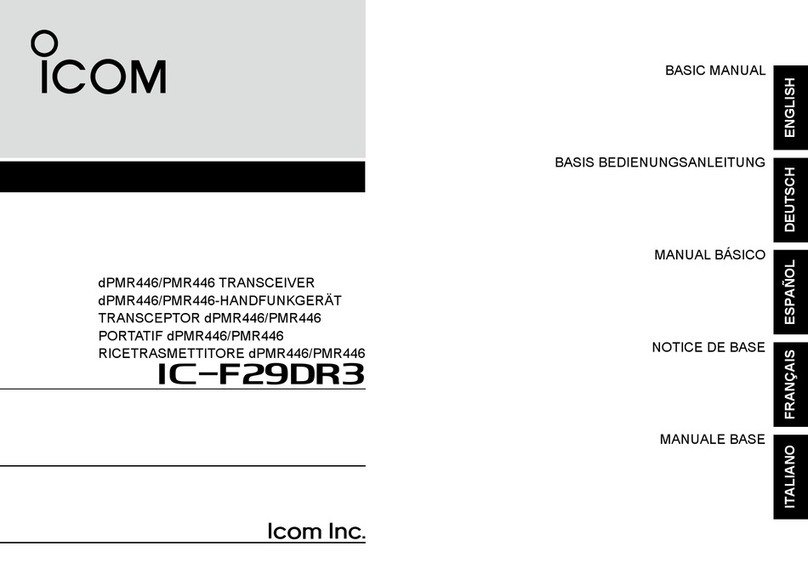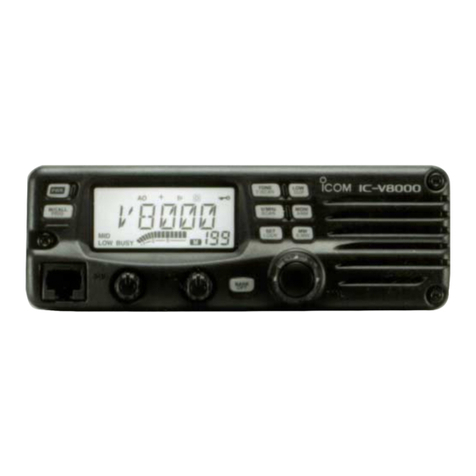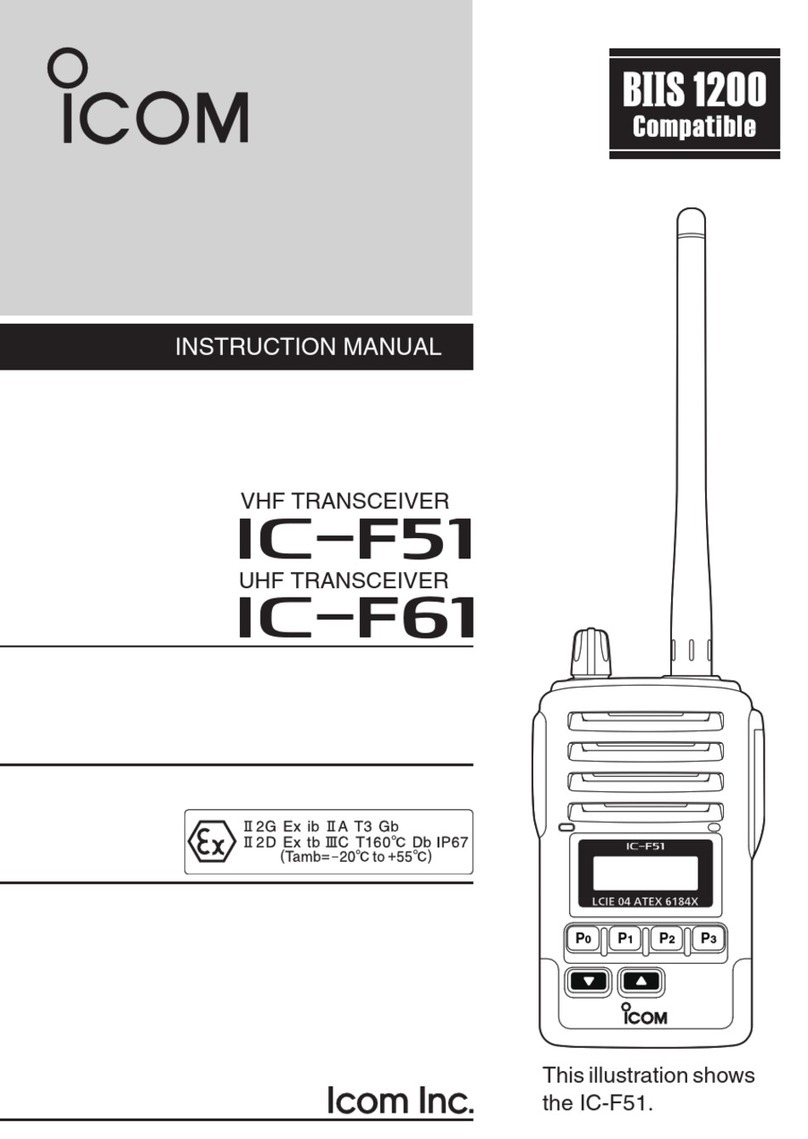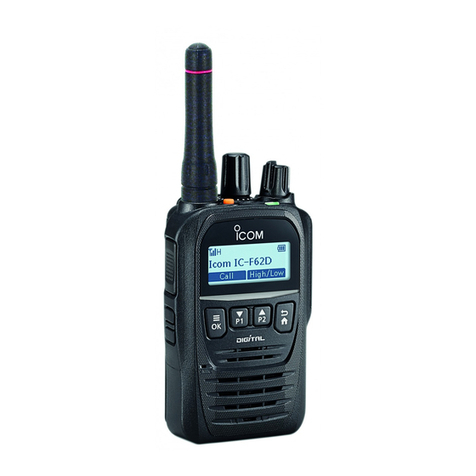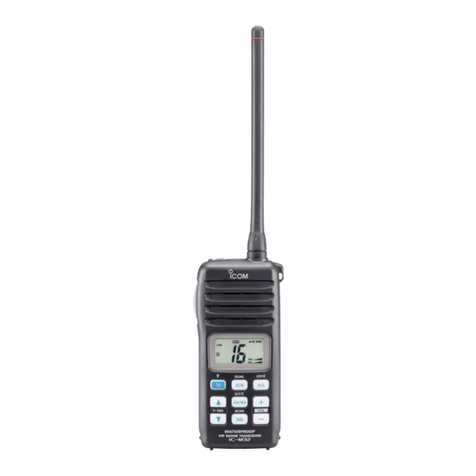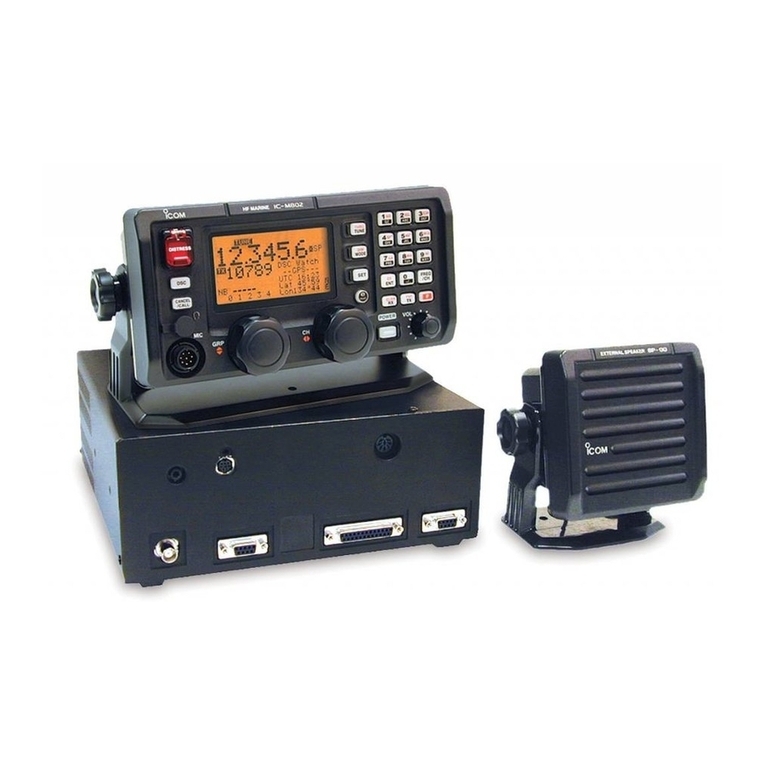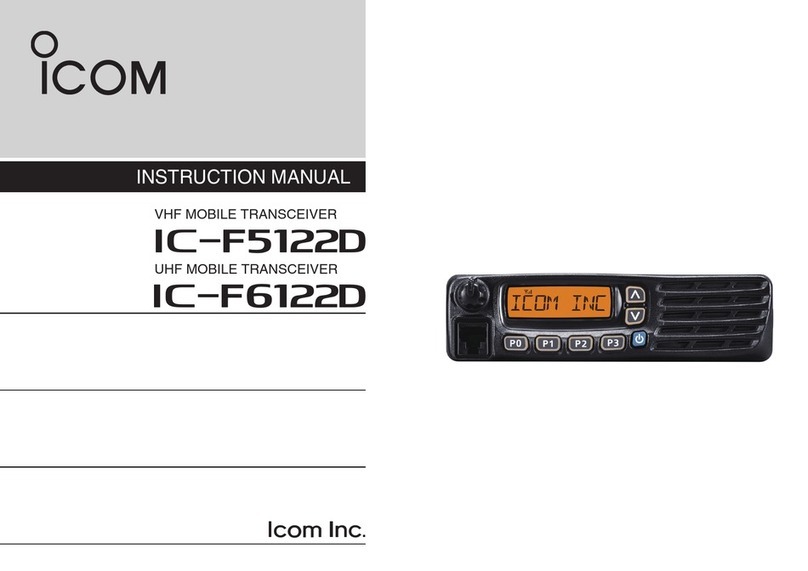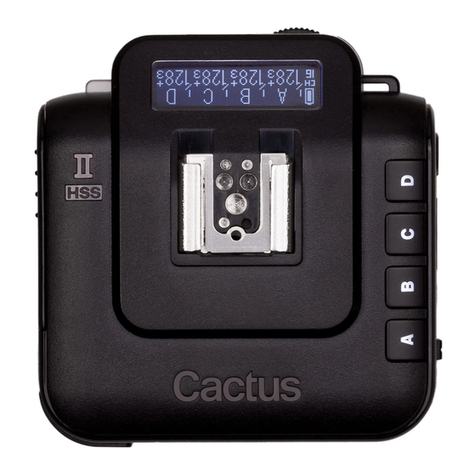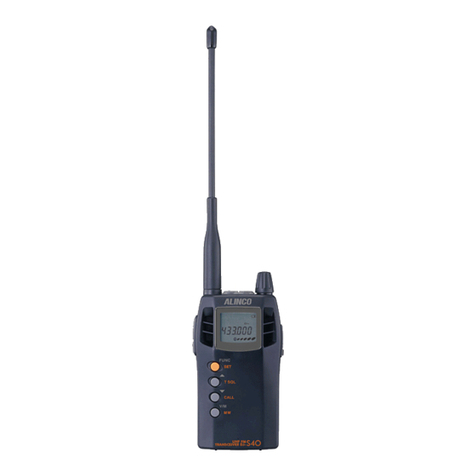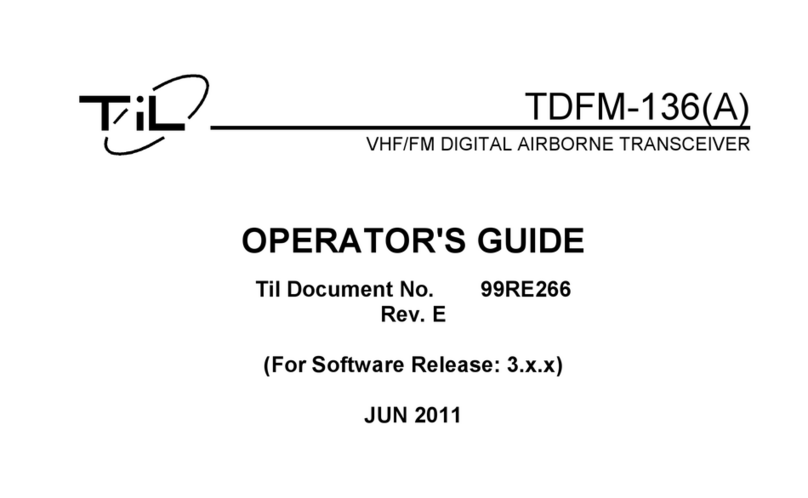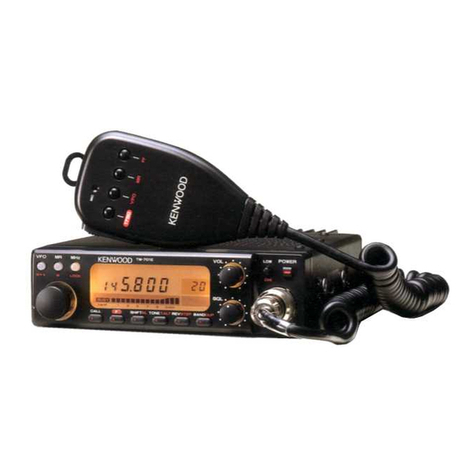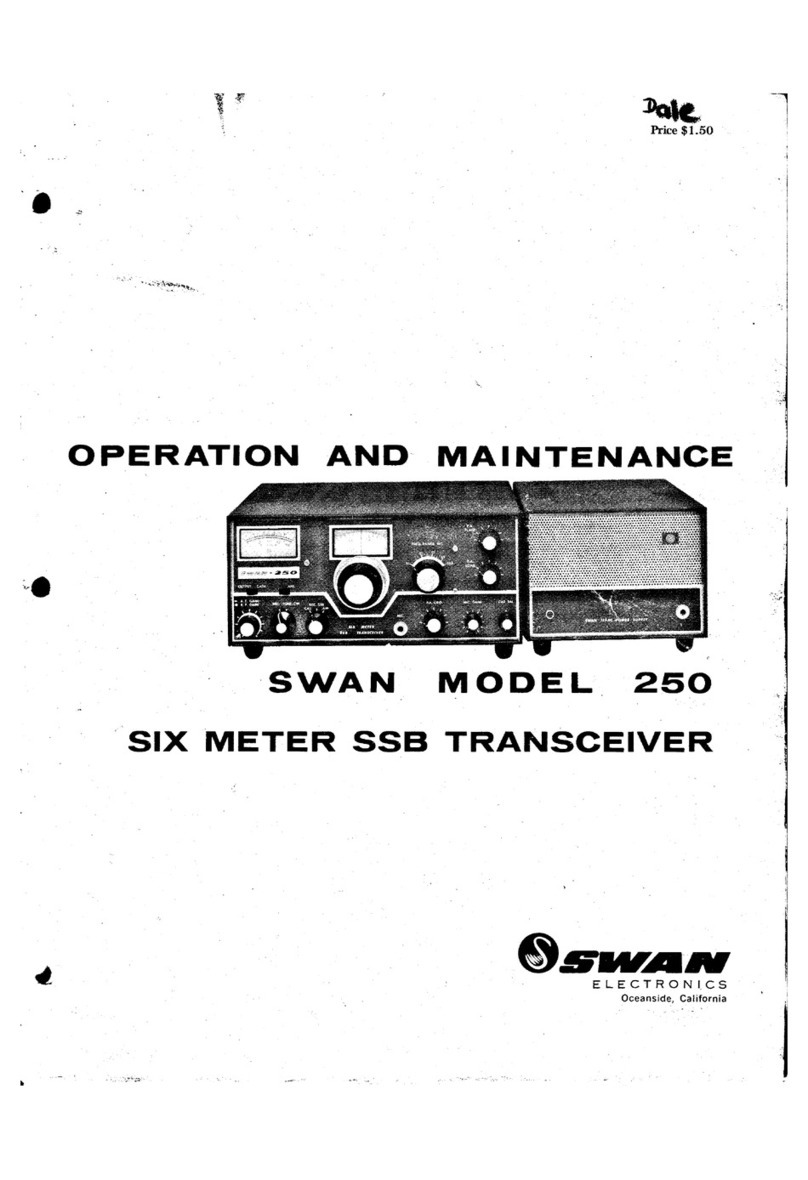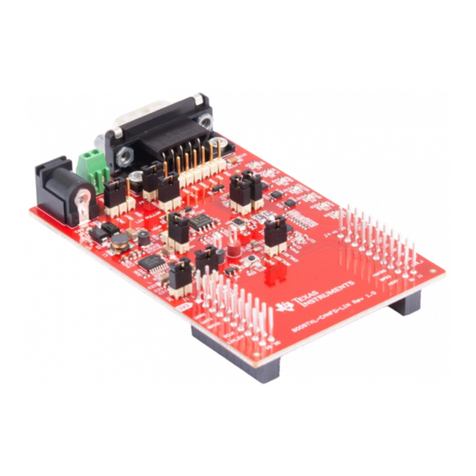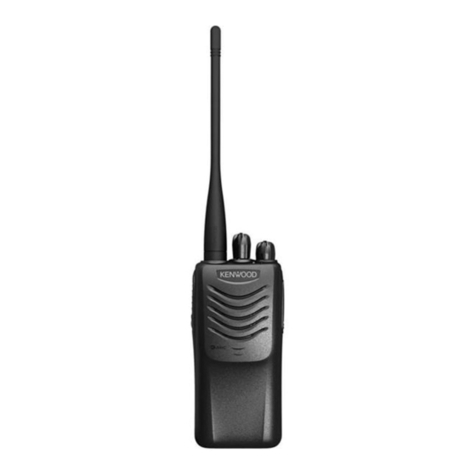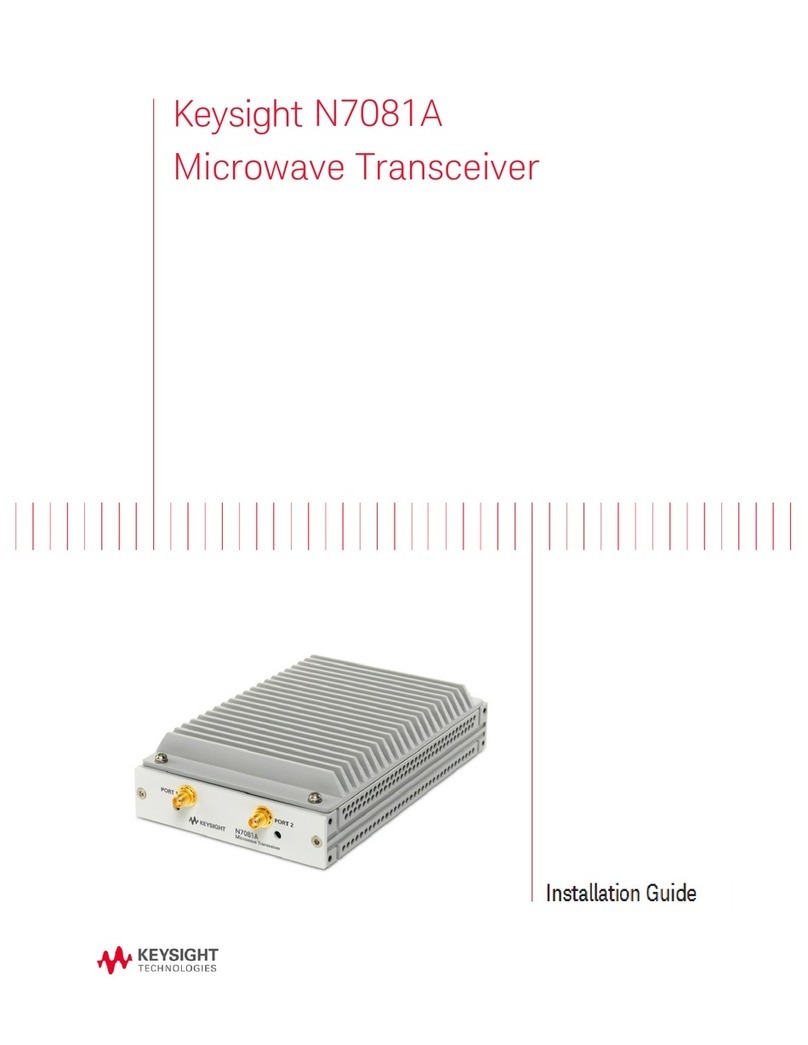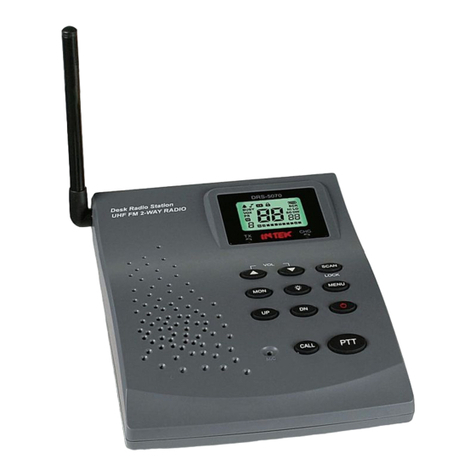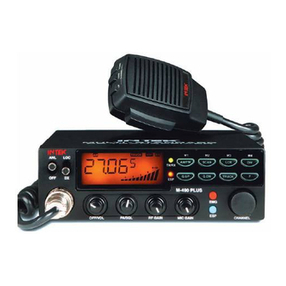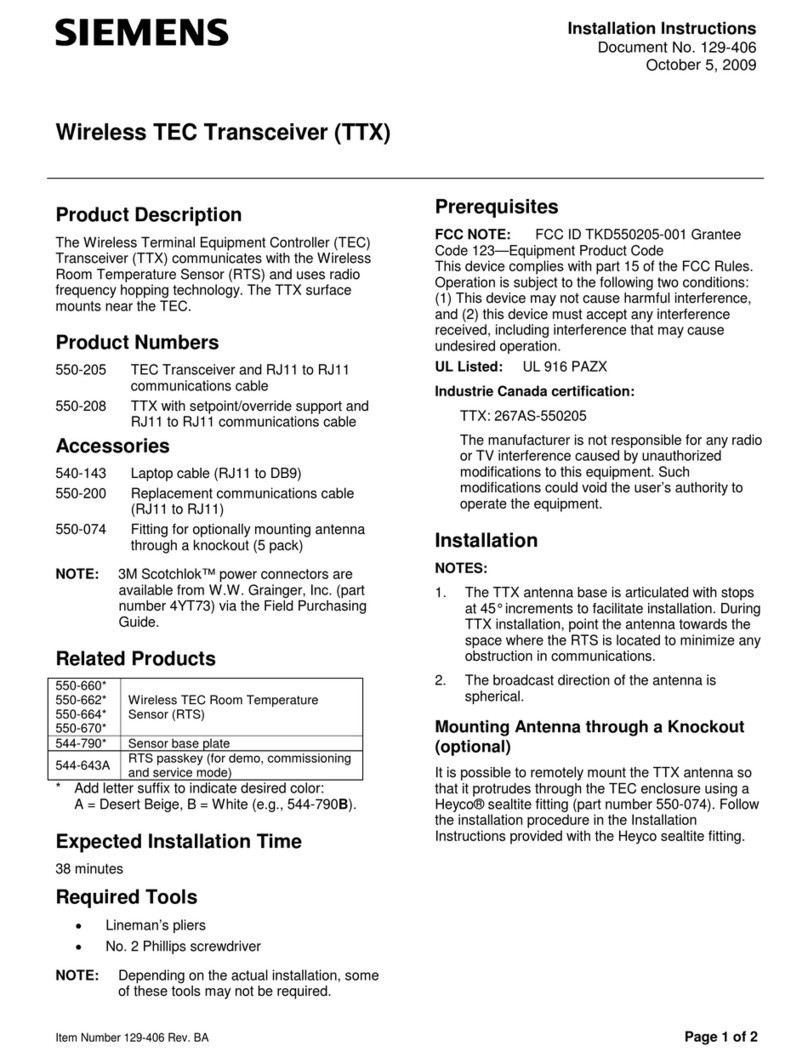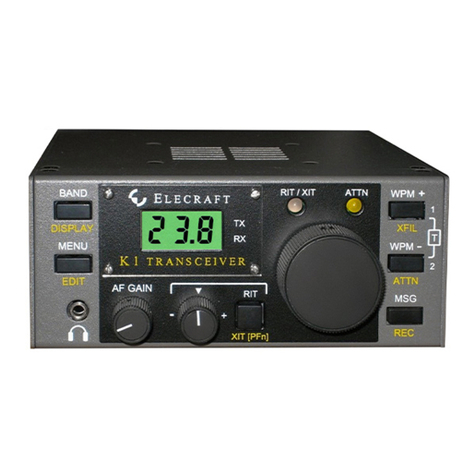Icom IC-F29SR2 User manual

PMR446 TRANSCEIVER
iF29SR2
OPERATING GUIDE

INTRODUCTION
1
Thank you for choosing this Icom product.
This product is designed and built with Icom’ s state
of the art technology and craftsmanship. With proper
care, this product should provide you with years of
trouble-free operation.
IMPORTANT
FIRST, CAREFULLY READ THE BASIC
MANUAL that is provided with the transceiver.
SAVE THIS OPERATING GUIDE— This
operating guide contains additional important operating
instructions for the IC-F29SR2 pmr446 transceiver.
Icom, Icom Inc. and the Icom logo are registered trademarks
of Icom Incorporated (Japan) in Japan, the United States,
the United Kingdom, Germany, France, Spain, Russia,
Australia, New Zealand, and/or other countries.
All other products or brands are registered trademarks or
trademarks of their respective holders.
TABLE OF CONTENTS
IMPORTANT............................................................... 1
1 ACCESSORIES ..................................................... 2
Accessory attachments .......................................... 2
DBattery pack........................................................ 2
DBelt clip ............................................................... 2
DJack cover........................................................... 3
2 PROGRAMMABLE KEY FUNCTIONS.................. 4
Programmable key functions.................................. 4
3 LED INDICATOR.................................................... 5
About the LED indicator ......................................... 5
4 SETTINGS ............................................................. 6
Setting the Beep function ....................................... 6
Setting the beep and announcement level ............. 7
Setting the ringer level............................................ 8
Setting the microphone gain................................... 9
Setting the squelch level ...................................... 10
Setting the VOX function .......................................11
Setting the VOX gain............................................ 12
Setting the group code number ............................ 13
DCTCSS tone setting .......................................... 13
DDTCS code setting............................................ 14

Section 1ACCESSORIES
DBattery pack
Attach or detach the battery pack, as shown to the
right.
To attach the battery pack:
1. Place the tabs on the bottom of the battery pack
into the slots at the bottom of the transceiver. (q)
2. Push the battery pack until the battery release
buttons make a ‘click’ sound. (w)
To detach the battery pack:
1. Push the battery release buttons in the direction
of the arrow, as shown to the right. (e)
2. The battery pack is then released, and you can
detach it. (r)
q
w
e
e
r
Battery release
buttons
To attach To detach
To attach To detach
w
e
Ta b
q
DBelt clip
NOTE: Before attaching or detaching the belt clip,
detach the battery pack from the transceiver, if it is
attached.
To attach the belt clip:
Slide the belt clip in the direction of the arrow until the
belt clip locks in place, and makes a ‘click’ sound. (q)
To detach the belt clip:
Lift the tab up (w), and slide the belt clip in the
direction of the arrow (e).
Accessory attachments
2

1ACCESSORIES
DJack cover
NOTE: The transceiver meets IP67 requirements
for dust-tight and waterproof protection only when
the jack cover or the optional HM-168LWP speaker
microphone is attached.
To attach the jack cover:
1. Place the jack cover over the speaker-microphone
jack. (q)
2. Insert and tighten the screws. (w)
e
er
w
w
q
To detach the jack cover:
1. Unscrew the screws using a Phillips screwdriver.
(e)
2. Detach the jack cover. (r)
Accessory attachments (Continued)
3
CAUTION: DO NOT detach the jack cover when
optional equipment is not in use. Otherwise the
terminals of the speaker microphone jack may be
shorted by a metal object, or become rusty by water
intrusion. This could damage the transceiver.

4
Section 2PROGRAMMABLE KEY FUNCTIONS
If you use the CS-F29SR2 programming software
(purchase separately), you can assign the functions
described below to [TOP], [Upper], and [Lower].
ZONE
zPush to select a desired Zone.
zHold down for 1 second to announce the current
Zone number.
LThe Zone number is announced when selecting a
Zone, regardless of the Channel Announce setting.
SCAN START/STOP
Push to start and stop a scan.
LWhen a scan is started with the Power ON Scan or
Automatic Scan function, push this key to pause it. The
paused scan resumes after a preset period of time.
PRIORITY A CHANNEL, PRIORITY B CHANNEL
Push to select the Priority A or Priority B channel.
PRIORITY A CHANNEL (REWRITE),
PRIORITY B CHANNEL (REWRITE)
zPush to select the Priority A or Priority B channel.
zHold down for 1 second to set the operating
channel as the Priority A or Priority B channel.
MEMORY CHANNEL 1, MEMORY CHANNEL 2
MEMORY CHANNEL 3, MEMORY CHANNEL 4
Push to select Memory channel 1, 2, 3, or 4.
MONI
zPush to turn the CTCSS (DTCS) mute ON or OFF.
zWhile holding down this key, the transceiver opens
any squelch, or releases any mute.
LOCK
Hold down for 1 second to turn the Key Lock function
ON or OFF.
LEven if the function is ON, [MONI] and [SURVEILLANCE]
are not locked.
SURVEILLANCE
zHold down for 1 second to turn ON the Surveillance
function.
zPush to turn OFF the function.
LWhen the function is ON and a signal is received, a
beep does not sound and the status indicator does not
light, even if you push any key.
SIREN
Hold down for 2 seconds to emit a siren sound.
LThe siren continues to sound until turning OFF the
transceiver.
LThis function is for situations other than an emergency
alert, such as a security alarm.
SCRAMBLER
zHold down for 1 second to turn ON the Voice
Scrambler function.
zPush to turn OFF the function.
COMPANDER
zHold down for 1 second to turn ON the Compander
function.
zPush to turn OFF the function.
LThe Compander function reduces noise components
from the transmitted audio to provide clear
communication.
S-RING/C-RING
zPush to make a Smart-Ring call.
zHold down for 1 second to make a Call-Ring call.
ANNOUNCE
Push to turn the Channel Announce function ON or OFF.
LThe transceiver announces the position of
[Rotary Selector].
LWhen the Beep function is OFF, the operating channel is
not announced, regardless of this setting. (p. 6)
ZONE/ANNOUNCE
zPush to select a desired Zone.
zHold down for 1 second to turn the Channel
Announce function ON or OFF.
LThe Zone number is announced when selecting a
Zone, regardless of the Channel Announce setting.
[TOP]
[Lower]
[Upper]
Programmable key functions
NOTE: Refer to the instruction manual that comes
with the transceiver for the default settings of these
keys.

5
Section 3LED INDICATOR
The LED indicator indicates the status of various
parameters of the transceiver as follows:
(Reference: R is Red, G is Green, O is Orange)
• Programming (reading or writing data)
• Programming error (if reading or writing fails)
• TX Low Battery 1 (while transmitting)
• TX Low Battery 2 (while transmitting)
• Transmitting
• Receiving
• Scanning
• Low Battery 1 (You should charge the battery.)
• Low Battery 2 (You must charge the battery.)
• When turning ON the power
• Making a Smart-Ring call
• Lockout, TX Inh, TOT (when transmit is inhibited)
• Smart-Ring call successful
• Smart-Ring call failed
• Siren
• Inh, Blank CH, Unlocked (when you cannot use
the channel)
G G G G G G G GGGGGGGGG
RG R G R G R G R G R G R G R GRGRGRGRGRGRGRGRG
RO R O R O R O R O R O R O R ORORORORORORORORO
R
RR
R
R
RR
RRRRR
R
R
G
GGG
G
G
G
GG
GG
GGG
G
GGG
G
GGGRRRROOOO
O
OO
OOO
O
OOOOO
O
OOOOO
R
R
O
O G
G
O
ORR
O
OOOOOOO G
GGGGGGG R
RRRR
RRR
About the LED indicator

6
Section 4SETTINGS
You can turn the Beep function ON or OFF. When it is
OFF, the channel announcement is also turned OFF.
[ROTARY SELECTOR]
[VOL]
[Lower]
[Upper]
NOTE: Turn ON the Beep function when you set the
beep and announce level, ringer level, microphone
gain, squelch level, VOX function, VOX gain, or the
group code number, to check the current level setting
by hearing the beeps. (pp. 7 ~ 14)
Setting the Beep function
1. Rotate [VOL] to turn OFF the transceiver.
2. Set [ROTARY SELECTOR] to any channel other
than Channel 16.
3. While holding down [Lower], rotate [VOL] to turn
ON the transceiver and enter the Beep Level
Adjustment mode.
• An opening beep sounds and the selected channel
number is announced.
4. Push [Lower] to turn the Beep function ON or
OFF.
• When a beep sounds after pushing [Lower], the Beep
function is ON.
• When no beep sounds after pushing [Lower], the Beep
function is OFF.
LThe transceiver stores the setting every time you
change it.
LIf desired, push [Upper] to adjust the beep level. See
page 7 for details.
5. Rotate [VOL] to turn OFF the transceiver and exit
the Beep Level Adjustment mode.

4SETTINGS
7
[ROTARY SELECTOR]
[VOL]
[Lower]
[Upper]
2
5
4
3
1
5 (Linked)
4 (Linked)
3 (Linked)
2 (Linked)
1 (Linked)
Pushing
[Upper]
You can adjust the beep and announcement level
between 1 and 5, or 1 (linked) and 5 (linked). When
a linked option is selected, the beep audio level is
adjustable by rotating [VOL].
NOTE: Turn ON the Beep function before you start
setting the beep and announcement level. (p. 6)
1. Rotate [VOL] to turn OFF the transceiver.
2. Set [ROTARY SELECTOR] to any channel other
than Channel 16.
3. While holding down [Lower], rotate [VOL] to turn
ON the transceiver and enter the Beep Level
Adjustment mode.
• An opening beep sounds and the selected channel
number is announced.
4. Push [Upper] to change the beep level.
• A beep sounds every time you push [Upper].
Therefore, you can determine the current level setting
by the increasing loudness of the beep that sounds.
InformationL
• The adjustable range is 1 ~ 5, or 1 (Linked) ~ 5
(Linked).
• Repeatedlypushing[Upper]rstselects1(lowest)to
5 (highest), and then selects the lowest linked level, 1
(Linked) to the highest, 5 (Linked).
Repeatedly pushing [Upper] repeats the cycle. See the
illustration to the right.
• To determine if you have selected a linked level, set
[VOL] to minimum, then push [Upper] repeatedly,
listening for the loudest beep (level 5). Pushing
[Upper] once after the loudest beep will select 1
(Linked). Repeatedly push [Upper] to select the
desired linked level.
5. Rotate [VOL] to turn OFF the transceiver and exit
the Beep Level Adjustment mode.
Setting the beep and announcement level

4SETTINGS
8
[ROTARY SELECTOR]
[VOL]
[Lower]
[Upper]
2
5
4
3
1
5 (Linked)
4 (Linked)
3 (Linked)
2 (Linked)
1 (Linked)
Pushing
[Lower]
Pushing
[Upper]
You can adjust the ringer level between 1 ~ 5, or
1 (Linked) ~ 5 (Linked). When a linked option is
selected, the ringer audio level is adjustable by
rotating [VOL].
Setting the ringer level
1. Rotate [VOL] to turn OFF the transceiver.
2. Set [ROTARY SELECTOR] to Channel 16.
3. While holding down [Lower], rotate [VOL] to turn
ON the transceiver and enter the Ringer Level
Adjustment mode.
• An opening beep sounds and “Sixteen” is announced.
4. Push [Upper] to increase, or push [Lower] to
decrease the ringer level.
• A beep sounds after pushing [Upper]. Therefore,
you can determine the current level setting by the
increasing loudness of the beep that sounds.
InformationL
• The adjustable range is 1 ~ 5, or 1 (Linked) ~ 5
(Linked).
• Repeatedlypushing[Upper]rstselects1(lowest)to
5 (highest), and then selects the lowest linked level,
1 (Linked) to the highest, 5 (Linked). Repeatedly
pushing [Upper] or [Lower] repeats the cycle. See the
illustration to the right.
• To determine if you have selected a linked level,
set [VOL] to minimum, then push [Upper] up to 10
times, listening for the loudest beep (level 5). Pushing
[Upper] once after the loudest beep will select 1
(Linked). Repeatedly push [Upper] or [Lower] to select
the desired linked level.
5. Rotate [VOL] to turn OFF the transceiver and exit
the Ringer Level Adjustment mode.
NOTE: Turn ON the Beep function before you start
setting the ringer level. (p. 6)

4SETTINGS
9
[ROTARY SELECTOR]
[VOL]
[Lower]
[Upper]
You can adjust the microphone gain. Higher values
make the microphone more sensitive to the user
voice.
NOTE: Turn ON the Beep function before you start
setting the microphone gain. (p. 6)
Setting the microphone gain
1. Rotate [VOL] to turn OFF the transceiver power.
2. Set [ROTARY SELECTOR] to Channel 16.
3. While holding down [Upper], rotate [VOL] to turn
ON the transceiver and enter the Microphone
Gain Adjustment mode.
• An opening beep sounds and “Sixteen” is announced.
4. Push [Upper] to increase, or push [Lower] to
decrease the microphone gain.
• A beep sounds after pushing [Upper] or [Lower]. An
error beep sounds if you try to exceed the adjustable
range.
LThe adjustable range is 1 (minimum) to 4
(maximum).
5. Rotate [VOL] to turn OFF the transceiver and exit
the Microphone Gain Adjustment mode.

4SETTINGS
10
[ROTARY SELECTOR]
[VOL]
[Lower]
[Upper]
You can adjust the squelch level. The squelch circuit
mutes the received audio, depending on the squelch
level setting.
Setting the squelch level
NOTE: Turn ON the Beep function before you start
setting the squelch level. (p. 6)
1. Rotate [VOL] to turn OFF the transceiver power.
2. Set [ROTARY SELECTOR] to any channel other
than Channel 16.
3. While holding down [Upper], rotate [VOL] to turn
ON the transceiver and enter the Squelch Level
Adjustment mode.
• An opening beep sounds and the selected channel
number is announced.
4. Push [Upper] to increase the squelch level (tight
squelch), or push [Lower] to decrease the squelch
level (loose squelch).
• A beep sounds after pushing [Upper] or [Lower]. An
error beep sounds if you try to exceed the adjustable
range.
LThe adjustable range is 0 (loose squelch) to 9 (tight
squelch).
5. Rotate [VOL] to turn OFF the transceiver and exit
the Squelch Level Adjustment mode.

4SETTINGS
11
You can turn the VOX function ON or OFF. The VOX
function automatically switches between receive and
transmit during voice operation.
[ROTARY SELECTOR]
[VOL]
[Upper]
[PTT]
Setting the VOX function
NOTE: Turn ON the Beep function before you start
setting the VOX function. (p. 6)
1. Rotate [VOL] to turn OFF the transceiver power.
2. Set [ROTARY SELECTOR] to any channel other
than Channel 16.
3. While holding down [PTT] and [Upper], rotate
[VOL] to turn ON the transceiver, to turn the VOX
function ON or OFF.
• When the VOX function is ON, a beep and an opening
beep sound, and then the selected channel number is
announced.
• When the VOX function is OFF, two beeps and an
opening beep sound, and then the selected channel
number is announced.
4. Rotate [VOL] to turn OFF the transceiver, then
turn ON again to restart the normal operation.

4SETTINGS
12
You can adjust the VOX gain. Higher values make the
VOX function more sensitive to the user voice.
[ROTARY SELECTOR]
[VOL]
[Lower]
[Upper]
[PTT]
Setting the VOX gain
NOTE: Turn ON the Beep function before you start
setting the VOX gain. (p. 6)
1. Rotate [VOL] to turn OFF the transceiver power.
2. Set [ROTARY SELECTOR] to Channel 16.
3. While holding down [PTT] and [Upper], rotate
[VOL] to turn ON the transceiver and enter the
VOX Gain Adjustment mode.
• An opening beep sounds and “Sixteen” is announced.
4. Push [Upper] to increase, or push [Lower] to
decrease the VOX gain.
• A beep sounds after pushing [Upper] or [Lower]. An
error beep sounds if you try to exceed the adjustable
range.
LThe adjustable range is 1 (minimum) to 10
(maximum).
5. Rotate [VOL] to turn OFF the transceiver and exit
the VOX Gain Adjustment mode.

13
4SETTINGS
DCTCSS tone setting
This transceiver has 50 preset CTCSS tones.
CTCSS operation enables silent standby, since you
will only receive calls from group members using the
same CTCSS tone. [ROTARY SELECTOR]
[VOL]
[Lower]
[Upper]
[PTT]
• Usable CTCSS tone list (Hz)
No. Freq. No. Freq. No. Freq. No. Freq. No. Freq.
01
02
03
04
05
06
07
08
09
10
67.0
69.3
71.9
74.4
77.0
79.7
82.5
85.4
88.5
91.5
11
12
13
14
15
16
17
18
19
20
94.8
97.4
100.0
103.5
107.2
110.9
114.8
118.8
123.0
127.3
21
22
23
24
25
26
27
28
29
30
131.8
136.5
141.3
146.2
151.4
156.7
159.8
162.2
165.5
167.9
31
32
33
34
35
36
37
38
39
40
171.3
173.8
177.3
179.9
183.5
186.2
189.9
192.8
196.6
199.5
41
42
43
44
45
46
47
48
49
50
00
203.5
206.5
210.7
218.1
225.7
229.1
233.6
241.8
250.3
254.1
OFF
Setting the group code number
[Example]: CTCSS tone No. 28 (162.2 Hz) assigned
to channel 4
1. Rotate [VOL] to turn OFF the transceiver.
2. Set [ROTARY SELECTOR] to Channel 4.
3. While holding down [PTT], [Upper], and [Lower],
rotate [VOL] to turn ON the transceiver.
4. Set [ROTARY SELECTOR] to Channel 4.
5. Hold down [Upper] until two beeps sound.
6. Push [PTT] two times to enter “2” (the ten’s digit)
of the number 28, then push [Upper].
• “Two” is announced.
7. Push [PTT] eight times to enter “8” (the one’s
digit) of the number 28, then push [Upper] to
complete the setting.
• “Eight” is announced.
8. Turn OFF the transceiver to set the CTCSS tone.
TIP:
• If you make a mistake, go back to step 1 and
follow all the steps again.
• To turn OFF the CTCSS tone, enter “00.”
1. Rotate [VOL] to turn OFF the transceiver.
2. Set [ROTARY SELECTOR] to any channel other
than Channel 16.
3. While holding down [PTT], [Upper], and [Lower],
rotate [VOL] to turn ON the transceiver.
• An opening beep sounds and the selected channel
number is announced.
4. Rotate [ROTARY SELECTOR] to select the
desired channel (1 to 16) that you want to assign
the CTCSS tone to.
5. Hold down [Upper] until two beeps sound.
• The transceiver enters the CTCSS Tone Setting mode.
6. Push [PTT] the necessary number of times to enter
the ten’s digit of the desired CTCSS tone number
(grey column) as shown in the list to the right.
LTo enter ‘0,’ skip this step.
7. Push [Upper].
• The selected number is announced.
8. Push [PTT] the necessary number of times to enter
the one’s digit of the desired CTCSS tone number
(grey column) as shown in the list to the right.
LTo enter ‘0,’ skip this step.
9. Push [Upper] to complete the setting.
• The selected number is announced.
10. Turn OFF the transceiver and exit the CTCSS
tone setting mode.

14
4SETTINGS
DDTCS code setting
This transceiver has 84 preset DTCS codes. DTCS
operation enables silent standby, since you will only
receive calls from group members using the same
DTCS code.
1. Rotate [VOL] to turn OFF the transceiver.
2. Set [ROTARY SELECTOR] to any channel other
than Channel 16.
3. While holding down [PTT], [Upper], and [Lower],
rotate [VOL] to turn ON the transceiver.
• An opening beep sounds and the selected channel
number is announced.
4. Rotate [ROTARY SELECTOR] to select the
desired channel (1 to 16) that you want to assign
the DTCS code to.
5. Hold down [Lower] until two beeps sound.
• The transceiver enters the DTCS Code Setting mode.
6. Push [PTT] the necessary number of times to enter
the ten’s digit of the desired DTCS code number
(grey column) as shown in the list to the right.
LTo enter ‘0,’ skip this step.
7. Push [Upper].
• The selected number is announced.
8. Push [PTT] the necessary number of times to enter
the one’s digit of the desired DTCS code number
(grey column) as shown in the list to the right.
LTo enter ‘0,’ skip this step.
9. Push [Upper].
• The selected number is announced.
10. If you want to use Inverse mode, push [PTT] again.
• If you want to use Normal mode, skip this step.
11. Push [Upper] to complete the setting.
12. Turn OFF the transceiver and exit the DTCS Code
Setting mode.
• Usable DTCS code list
No. Code No. Code No. Code No. Code No. Code
01
02
03
04
05
06
07
08
09
10
11
12
13
14
15
16
17
18
19
20
023
025
026
031
032
036
043
047
051
054
065
071
072
073
074
114
115
116
125
131
21
22
23
24
25
26
27
28
29
30
31
32
33
34
35
36
37
38
39
40
132
134
143
152
155
156
162
165
172
174
205
223
226
243
244
245
251
261
263
265
41
42
43
44
45
46
47
48
49
50
51
52
53
54
55
56
57
58
59
60
271
306
311
315
331
343
346
351
364
365
371
411
412
413
423
431
432
445
464
465
61
62
63
64
65
66
67
68
69
70
71
72
73
74
75
76
77
78
79
80
466
503
506
516
532
546
565
606
612
624
627
631
632
654
662
664
703
712
723
731
81
82
83
84
00
732
734
743
754
OFF
[ROTARY SELECTOR]
[VOL]
[Lower]
[Upper]
[PTT]
Setting the group code number (Continued)
[Example]: DTCS code No. 16 (114) Inverse mode
assignment to channel 5
1. Rotate [VOL] to turn OFF the transceiver.
2. Set [ROTARY SELECTOR] to Channel 5.
3. While holding down [PTT], [Upper], and [Lower],
rotate [VOL] to turn ON the transceiver.
4. Hold down [Lower] until two beeps sound.
5. Push [PTT] one time to enter “1” (the ten's digit) of
the number 16, then push [Upper].
• “One” is announced.
6. Push [PTT] six times to enter “6” (the one’s digit)
of the number 16, then push [Upper].
• “Six” is announced.
7. Push [PTT] again, to use Inverse mode.
8. Push [Upper] to complete the setting.
9. Turn OFF the transceiver to set the DTCS code.
TIP:
• If you make a mistake, go back to step 1 and
follow all the steps again.
• To turn OFF the DTCS code, enter “0.”

1-1-32 Kamiminami, Hirano-ku, Osaka 547-0003, Japan
A-7360-3EU
© 2017 Icom Inc.
Other manuals for IC-F29SR2
1
Table of contents
Other Icom Transceiver manuals

